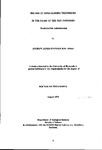THE USE OF GENE CLONING TECHNIQUES IN THE STUDY OF THE FISH PATHOGEN Renibacterium salmoninarum
| dc.contributor.author | EVENDEN, ANDREW JAMES | |
| dc.contributor.other | School of Biological and Marine Sciences | en_US |
| dc.date.accessioned | 2013-10-03T11:33:20Z | |
| dc.date.available | 2013-10-03T11:33:20Z | |
| dc.date.issued | 1993 | |
| dc.identifier | NOT AVAILABLE | en_US |
| dc.identifier.uri | http://hdl.handle.net/10026.1/1998 | |
| dc.description.abstract |
A programme of research was undertaken to assess the feasibility of the application of gene cloning techniques to Renibacteriun salmoninarum, an important, but as yet poorly characterized pathogen of salmonid fish. Difficulties encountered during in vitro culture, have restricted our knowledge of the bacterium, especially with respect to ita mechanisms and molecules of pathogenicity. A collection of R.salmoninarum isolates was made, and an initial study conducted to determine target molecules for cloning. All strains tested were found to have uniform protein profiles when analysed with SOS-PAGE, and uniform antigenic profiles when subject to immunoblotting experiments utilizing rabbit antisera raised against both whole cell and ECP preparations of the bacterium. The presence of haemolytic and proteolytic activity, putative pathogenicity determinants of R.salmoninarum, could not be established. Genomic DNA extracted from isolates of R.salmoninarum was used to construct gene libraries in a variety of E. coli K/2 host vector systems. Gene libraries were screened with antisera for the presence of R.salmoninarum antigens, and with erythrocytes and a range of natural and synthetic substrates for the presence of haemolytic and proteolytic components. As a result of the screening process, a stable haemolytic E. coli "clone was detected and isolated from a pHC79/R.salmoninarum/Sau3A gene library. This clone contained the recombinant cosmid molecule pRHLY1 bearing a gene for RHLY, a putative R.salmoninarum haemolysin on a DNA insert of approximately 32 kbp. The RHLY encoding gene, designated rsh, was subcloned on a 1.65 kbp DNA fragment to form the recombinant plasmid pRHLYll, for which a preliminary restriction endonuclease cleavage map was constructed. Southern blot hybridization was performed, and established that the fragment containing the rsh gene was a true representative of a R.salmoninarun genomic DNA sequence, present in all isolates studied. Mini cell analysis of the cloned rsh gene and immunoblot of the pRHLY -containing E. coli clone with antiserum to R.salmoninarum whole cells, revealed that haemolytic activity is mediated by a protein of an approximate size of 48-50 kDa. Haemolytic activity could not be detected in cell-free assay and RHLY was not purified, but experiments conducted with RHLY -containing E. coli indicated that the protein is active against a wide spectrum of animal erythrocytes, across a wide temperature range. The specific mode of cytolytic activity was not established. Immunoblot analysis utilizing an antiserum raised to a β-galactosidase/RHLY fusion protein, revealed that a similar protein is found in whole cell preparations of R.salmoninarum. The nucleotide sequence of the rsh gene was determined, and was shown to contain an ORF of 1248 bp. Putative transcriptional/translational control regions were identified for the rsh gene, and the primary amino acid sequence of the RHLY protein determined. A computer-aided search of the PIR protein sequence database, failed to detect any protein with significant homology to RHLY, therefore, conclusive evidence for structure/function of the molecule was not obtained. However, the RHLY protein was found to have a 30-35 amino acid motif, conserved and repeated twice, that shares significant homology with a repeated motif in the sequence of dniR protein, the product of a gene in E. coli K12 that regulates the expression of the enzyme nitrite reductase. Future studies of the RHL Y protein, the rsh gene, and other components of R.salmoninarum are discussed. | en_US |
| dc.description.sponsorship | SOAFD Marine Laboratory, Aberdeen, Scotland | en_US |
| dc.language.iso | en | en_US |
| dc.publisher | University of Plymouth | en_US |
| dc.title | THE USE OF GENE CLONING TECHNIQUES IN THE STUDY OF THE FISH PATHOGEN Renibacterium salmoninarum | en_US |
| dc.type | Thesis | |
| plymouth.version | Full version | en_US |
| dc.identifier.doi | http://dx.doi.org/10.24382/4398 | |
| dc.identifier.doi | http://dx.doi.org/10.24382/4398 |
Files in this item
This item appears in the following Collection(s)
-
01 Research Theses Main Collection
Research Theses Main


